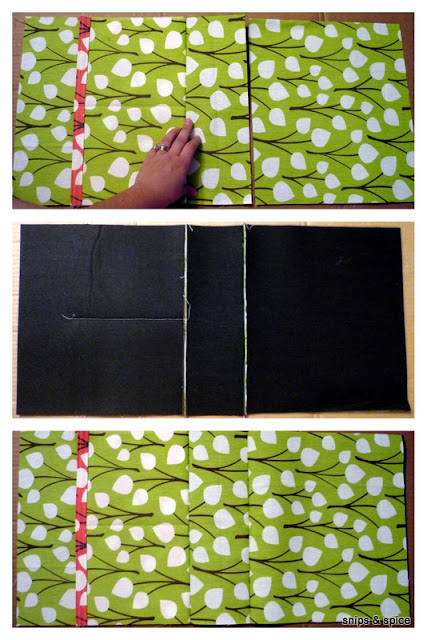Supplies
- Scissors
- Rotary cutter and mat (optional, but so helpful)
- Sewing machine & thread
- Pins
- 1 yard decorator's/indoor canvas (one side)
- 1 yard decorator's/indoor canvas (other side)
- Soft & Stable (for the bag body) - this is optional, but it is a great product. It is lighter than batting, and more stable. You could use batting, or if you want a floppier bag, don't line it with anything.
- Iron & ironing board
- Pencil/pen
- CD or DVD
- Ruler or measuring tape
| soft and stable |
***unless otherwise stated, the entire pattern uses 1/4 inch seam allowances***
***these directions pertain to directional fabric; if yours does not have a direction, you can ignore directions***
- Begin by cutting each of your fabrics into the following sizes (the picture is to help people with directional fabric):
- 13 x 11.5 front (cut 1 soft and stable)
- 13 x 11.5 back (cut 1 soft and stable)
- 4.5 x 11.5 sides (2) (cut 2 soft and stable)
- 13 x 11.5 flap
- 4.5 x 13 bottom (cut 1 soft and stable)
- 4.5 x 5.5 side pockets (2)
- 4.5 x 7 side pocket liners (2)
- 13 x 7.5 front pocket
- 13 x 9 front pocket liner
- 3 x 43 strap
- Make your strap. Stack the straps right sides together and sew along both long sides. Flip right sides out, iron, then sew 1/4 inch from the edge along the long sides again.
- Make your pockets.
- Match your side pockets and side pocket liners. The pocket liners should be 1.5 inches taller than the pockets.
- Stack and pin your pieces along the shorter side right sides together so that the top of the pocket matches with the bottom of the pocket liner.
- Sew pocket and liner together.
- Iron the seam allowances toward the pocket liner.
- Fold the pocket on top of the liner to match the bottom corners of the liner and the pocket.
- Iron them flat.
- Top stitch along the top of the pocket to stabilize. I stitched two rows of top stitching for decorative effect.
- Repeat the process with the front pocket sewing along the longer edge this time.
- When you are finished you will have all of the above pockets.
- Make your flap.
- Trace your cd/dvd on the two bottom corners of each of your flap pieces.
- Cut the corners so they are round.
- Stack the two flap pieces right sides together.
- Sew around the sides and bottom edges - leaving the top open. Clip around the corners.
- Flip inside out, iron, and sew 1/4 inch from the edge for the three sides you just sewed.
- Sew together bag body.
- Stack in the following order: the front piece of soft and stable, the front fabric right side up, the front pocket right side up, the bottom fabric right side down, the bottom soft and stable. Sew together.
- Mark down the center of the front pocket, then sew down to create two smaller pockets.
- Sew bag back onto the bag body by attaching to the bottom. Stack the bottom (soft and stable with bottom fabric), back fabric, and back soft and stable, then sew.
- Sew the sides to the front of the bag (remember to include the pockets and the soft and stable).
- Sew the sides to the back of the bag. You will have an opening at the bottom of each side. Pin sides to bottom, and sew a straight line to close the opening.
- Repeat entire process for the other bag fabric (minus the soft and stable). For the sake of this tutorial, we will call this the lining from now on, but understand this is not actually lining since the bag is reversible. I sewed three lines down the front pocket of this one to create pen/pencil pockets.
- Sew the flap to the bag body with the soft and stable. I sew just a little less than 1/4 inch seam allowance to ensure this seam does not show when the two sides are sewn together.
- Pin the strap into the bag body. Be sure to not twist the strap when you pin.
- With the bag right side in, place the lining right side out inside the bag and pin together around the top. Be sure to catch the straps in the pins and make the pockets line up on the same side. Sew around the top leaving a gap at the back to turn the back right side out.
- Turn the bag right side out, then pin around the top.
- Sew 1/4 inch around the top to stabilize the bag--be sure to catch the opening and sew it shut when you sew around the top.






